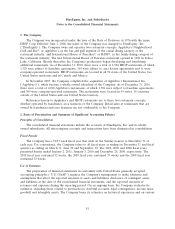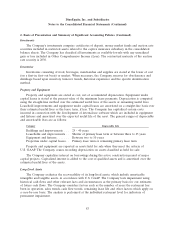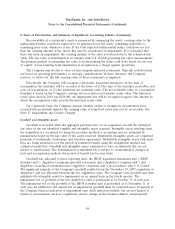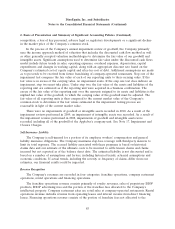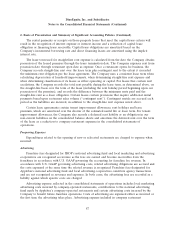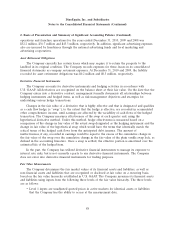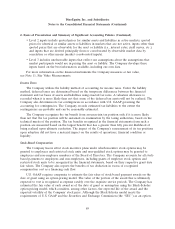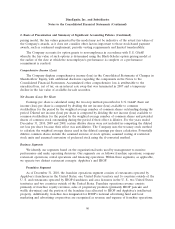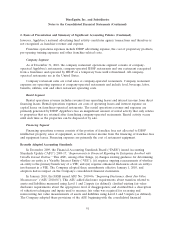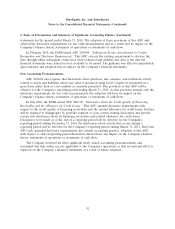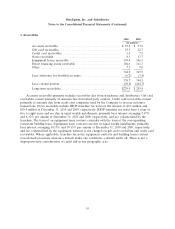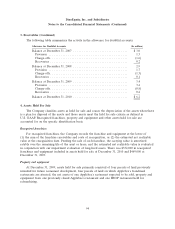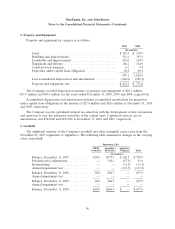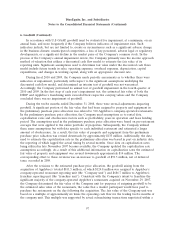IHOP 2010 Annual Report Download - page 105
Download and view the complete annual report
Please find page 105 of the 2010 IHOP annual report below. You can navigate through the pages in the report by either clicking on the pages listed below, or by using the keyword search tool below to find specific information within the annual report.DineEquity, Inc. and Subsidiaries
Notes to the Consolidated Financial Statements (Continued)
2. Basis of Presentation and Summary of Significant Accounting Policies (Continued)
• Level 2 inputs include quoted prices for similar assets and liabilities in active markets, quoted
prices for identical or similar assets or liabilities in markets that are not active, inputs other than
quoted prices that are observable for the asset or liability (i.e., interest rates, yield curves, etc.),
and inputs that are derived principally from or corroborated by observable market data by
correlation or other means (market corroborated inputs).
• Level 3 includes unobservable inputs that reflect our assumptions about the assumptions that
market participants would use in pricing the asset or liability. The Company develops these
inputs based on the best information available, including our own data.
For more information on the financial instruments the Company measures at fair value,
see Note 11, Fair Value Measurements.
Income Taxes
The Company utilizes the liability method of accounting for income taxes. Under the liability
method, deferred taxes are determined based on the temporary differences between the financial
statement and tax bases of assets and liabilities using enacted tax rates. A valuation allowance is
recorded when it is more likely than not that some of the deferred tax assets will not be realized. The
Company also determines its tax contingencies in accordance with U.S. GAAP governing the
accounting for contingencies. The Company records estimated tax liabilities to the extent the
contingencies are probable and can be reasonably estimated.
The Company recognizes the tax benefit from an uncertain tax position only if it is more likely
than not that the tax position will be sustained on examination by the taxing authorities, based on the
technical merits of the position. The tax benefits recognized in the financial statements from such a
position are measured based on the largest benefit that has a greater than fifty percent likelihood of
being realized upon ultimate resolution. The impact of the Company’s reassessment of its tax positions
upon adoption did not have a material impact on the results of operations, financial condition or
liquidity.
Stock-Based Compensation
The Company has in effect stock incentive plans under which incentive stock options may be
granted to employees and restricted stock units and non-qualified stock options may be granted to
employees and non-employee members of the Board of Directors. The Company accounts for all stock-
based payments to employees and non-employees, including grants of employee stock options and
restricted stock units to be recognized in the financial statements, based on their respective grant date
fair values. The Company also reports the benefits of tax deduction in excess of recognized
compensation cost as a financing cash flow.
U.S. GAAP requires companies to estimate the fair value of stock-based payment awards on the
date of grant using an option-pricing model. The value of the portion of the award that is ultimately
expected to vest is recognized as expense ratably over the requisite service periods. The Company has
estimated the fair value of each award as of the date of grant or assumption using the Black-Scholes
option pricing model, which considers, among other factors, the expected life of the award and the
expected volatility of the Company’ stock price. Although the Black-Scholes model meets the
requirements of U.S. GAAP and the Securities and Exchange Commission (the ‘‘SEC’’) as an option-
89




